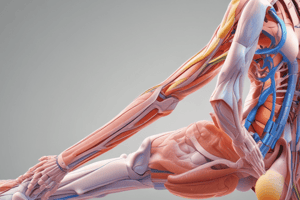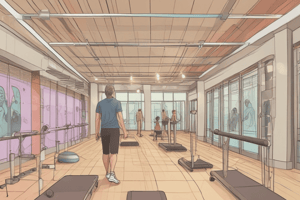Podcast
Questions and Answers
What is the primary purpose of Passive ROM (PROM)?
What is the primary purpose of Passive ROM (PROM)?
- To completely immobilize a joint or tissue
- To facilitate active movement of the segment being exercised
- To assist in circulation and reduce edema (correct)
- To increase muscle strength through voluntary contraction
Which of the following is NOT a characteristic of relaxed passive movement?
Which of the following is NOT a characteristic of relaxed passive movement?
- Movement through the available range
- Regular rhythm
- Slow pace
- Voluntary muscle contraction (correct)
What is one of the main goals of using Passive ROM?
What is one of the main goals of using Passive ROM?
- To strengthen muscles through resistance
- To maximize pain during movement
- To immobilize joints completely
- To maintain unrestricted range of motion (correct)
In which scenario is PROM most beneficial?
In which scenario is PROM most beneficial?
Which of the following indicates a potential use for PROM?
Which of the following indicates a potential use for PROM?
What is the primary purpose of maintaining the extensibility of muscles?
What is the primary purpose of maintaining the extensibility of muscles?
What effect does complete immobility have on the body?
What effect does complete immobility have on the body?
Which of the following is NOT a limitation of passive motion?
Which of the following is NOT a limitation of passive motion?
What does range of motion (ROM) primarily refer to?
What does range of motion (ROM) primarily refer to?
What factor is important to monitor during early controlled motion in rehab?
What factor is important to monitor during early controlled motion in rehab?
Which factor is least likely to lead to decreased range of motion?
Which factor is least likely to lead to decreased range of motion?
Which scenario is a contraindication for passive range of motion exercises?
Which scenario is a contraindication for passive range of motion exercises?
How does muscular endurance differ from muscular strength?
How does muscular endurance differ from muscular strength?
What effect can soft tissues like ligaments and tendons have on joint motion?
What effect can soft tissues like ligaments and tendons have on joint motion?
What is a potential benefit of early, continuous passive range of motion (PROM)?
What is a potential benefit of early, continuous passive range of motion (PROM)?
What is one of the purposes of therapeutic range of motion (ROM) activities?
What is one of the purposes of therapeutic range of motion (ROM) activities?
What can hypermobility and hypomobility of joints affect?
What can hypermobility and hypomobility of joints affect?
What is meant by 'adaptive shortening' of a muscle?
What is meant by 'adaptive shortening' of a muscle?
Which type of passive movement is used specifically to break down adhesions?
Which type of passive movement is used specifically to break down adhesions?
Elbow flexion is generally limited by which of the following?
Elbow flexion is generally limited by which of the following?
Which joint structure primarily determines the range of movement possible at a joint?
Which joint structure primarily determines the range of movement possible at a joint?
What is essential for a therapist to effectively apply passive range of motion (PROM) techniques?
What is essential for a therapist to effectively apply passive range of motion (PROM) techniques?
What should be ensured about the patient's positioning during PROM?
What should be ensured about the patient's positioning during PROM?
How should the therapist conduct the passive movement of a joint?
How should the therapist conduct the passive movement of a joint?
What is a crucial aspect of the therapist's grasp during PROM?
What is a crucial aspect of the therapist's grasp during PROM?
Which of the following describes the type of motion used in continuous passive movement (CPM)?
Which of the following describes the type of motion used in continuous passive movement (CPM)?
What does traction during PROM aim to achieve?
What does traction during PROM aim to achieve?
During PROM, what should the therapist avoid while moving the joint?
During PROM, what should the therapist avoid while moving the joint?
How many repetitions of passive movements are typically recommended?
How many repetitions of passive movements are typically recommended?
Flashcards are hidden until you start studying
Study Notes
Range of Motion (ROM)
- ROM is the amount of movement at a joint.
- Tissue flexibility allows tissues (muscles, tendons) to lengthen for normal joint motion.
- Joint structure and soft tissue integrity affect ROM.
- Maintaining normal ROM requires periodic movement through available ranges.
- Decreased ROM can result from disease, injury, inactivity, or immobilization.
- Therapeutic ROM activities maintain joint and soft tissue mobility, minimizing contractures.
- ROM is limited by joint capsules, ligaments, tendons, bony configuration, and soft tissue bulk.
- Joint surface shape dictates movement direction; disease or trauma can alter this.
- Hypermobility exceeds normal ROM; hypomobility is less than normal ROM.
Passive Movement (PROM)
- PROM is movement produced entirely by external force, without voluntary muscle contraction.
- External forces include gravity, machines, another person, or another body part.
- Relaxed PROM maintains unrestricted ROM.
- PROM for stretching increases restricted ROM to full ROM.
- PROM for mobilization breaks down adhesions and increases ROM.
- Relaxed PROM characteristics: slow, rhythmic, regular, within available ROM.
Goals of PROM
- Maintain joint and connective tissue mobility and unrestricted ROM.
- Minimize contractures and adhesion formation.
- Maintain muscle mechanical elasticity (ability to return to original length and shape).
- Assist circulation and vascular dynamics.
- Enhance cartilage nutrition and synovial fluid movement.
- Decrease or inhibit pain.
- Assist healing after injury or surgery.
- Maintain patient’s awareness of movement.
- PROM exerts mechanical pressure, stretching thin-walled vessels, assisting venous and lymphatic return, reducing edema.
Indications for PROM
- Acutely inflamed tissue (inflammation after injury or surgery usually lasts 2-6 days).
- Coma.
- Paralysis.
- Complete bed rest.
- Muscle re-education.
Other Uses for PROM
- Examination: determining limitations of motion, joint stability, muscle and soft tissue elasticity.
- Demonstrating desired motion during active exercise programs.
- Maintaining ROM and muscle extensibility, preventing adaptive shortening and adhesion formation.
- Preserving memory of movement patterns in paralysis, stimulating kinesthetic receptors.
- When patients can't actively move body segments.
- Complete immobility leads to adhesions, contractures, sluggish circulation, and prolonged recovery.
Limitations of Passive Motion
- Does not prevent muscle atrophy, increase strength or endurance, or assist circulation as effectively as active muscle contraction.
- Muscular strength is maximal voluntary tension or force.
- Muscular endurance is ability to perform repeated contractions or maintain isometric contraction.
Contraindications to PROM
- Immediately after acute tears, fractures, surgery (recent injury).
- Motion disruptive to healing.
- Fever.
- Acute inflammation.
- Increased blood pressure.
- Deep venous thrombosis.
- Open wounds.
- Severe pain.
Precautions for PROM
- Early, continuous PROM within pain-free limits benefits healing and recovery.
- Controlled motion decreases pain and increases recovery rate.
- Monitor patient tolerance; increased pain or inflammation indicates stopping.
Principles and Procedures for Applying PROM
- Therapist needs knowledge of anatomy (joint motions, normal ROM, muscle origin/insertion, function).
- Explain purpose and method.
- Position patient comfortably with proper body alignment, allowing for ROM.
- Position yourself for proper body mechanics.
- Support body part and grasp comfortably near the joint.
- Use both hands to support, grasping above and below.
- Grasp should be firm but not harmful.
- Apply traction to distal segments to reduce friction.
- No active resistance.
- Move through pain-free ROM to tissue resistance, not beyond.
- Movement direction is the same as active movements.
- Relaxed movement is slow and rhythmic, 5-10 repetitions (depending on patient).
Continuous Passive Motion (CPM)
- Mechanical device for slow, rhythmic, continuous movement through a controlled ROM.
Studying That Suits You
Use AI to generate personalized quizzes and flashcards to suit your learning preferences.




